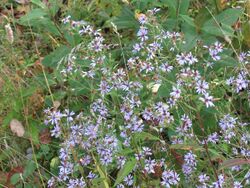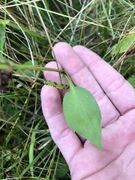Biology:Symphyotrichum ciliolatum
| Symphyotrichum ciliolatum | |
|---|---|

| |
| In Ontario, Canada | |
| Scientific classification Error creating thumbnail: Unable to save thumbnail to destination
| |
| Kingdom: | Plantae |
| Clade: | Tracheophytes |
| Clade: | Angiosperms |
| Clade: | Eudicots |
| Clade: | Asterids |
| Order: | Asterales |
| Family: | Asteraceae |
| Tribe: | Astereae |
| Subtribe: | Symphyotrichinae |
| Genus: | Symphyotrichum |
| Subgenus: | Symphyotrichum subg. Symphyotrichum |
| Section: | Symphyotrichum sect. Symphyotrichum |
| Species: | S. ciliolatum
|
| Binomial name | |
| Symphyotrichum ciliolatum | |

| |
| Native distribution[2] | |
| Synonyms[2] | |
|
Basionym
Alphabetical list
| |
Symphyotrichum ciliolatum (formerly Aster ciliolatus), commonly known as Lindley's aster and fringed blue aster, is a perennial herb native to Canada and the northern United States . It is also known as ciliolate wood aster and northern heart-leaved aster.[3][4] The common name Lindley's aster honours John Lindley who first described the species in 1834.[5]
Description
Symphyotrichum ciliolatum can reach heights of up to 1.2 metres (3 feet 11 inches) and can spread via long rhizomes. The leaves are typically heart-shaped with winged petioles. Flowering occurs between late July and October. The ray florets are blue or bluish purple, and the disc florets are yellow, becoming reddish purple with maturity.[5]
Taxonomy
Hybrids with Symphyotrichum laeve, Symphyotrichum novi-belgii (named Symphyotrichum x subgeminatum),[5] and possibly Symphyotrichum lanceolatum have been recorded.[4]
Distribution and habitat
Symphyotrichum ciliolatum grows in open forests, forest edges, thickets and along streams, trails, and roadsides. It occurs across Canada from Yukon to Newfoundland, and in the northern United States from Montana to New York.[5]
Citations
References
- "Symphyotrichum ciliolatum (Lindley) Á. Löve & D. Löve". Database of Vascular Plants of Canada (VASCAN). 2020. https://data.canadensys.net/vascan/taxon/3529/.
- Flora of North America Editorial Committee, ed. (2006), "Symphyotrichum ciliolatum", Flora of North America North of Mexico (FNA), 20, New York and Oxford, http://www.efloras.org/florataxon.aspx?flora_id=1&taxon_id=250067632, retrieved 7 January 2020
- "Symphyotrichum ciliolatum Lindley's Aster". Arlington, Virginia. 1 August 2021. https://explorer.natureserve.org/Taxon/ELEMENT_GLOBAL.2.147434.
- POWO (2019). "Symphyotrichum ciliolatum (Lindl.) Á.Löve & D.Löve". Royal Botanic Gardens, Kew. https://powo.science.kew.org/taxon/urn:lsid:ipni.org:names:247112-2.
- Template:Cite Michigan Flora
Wikidata ☰ {{{from}}} entry
 |




